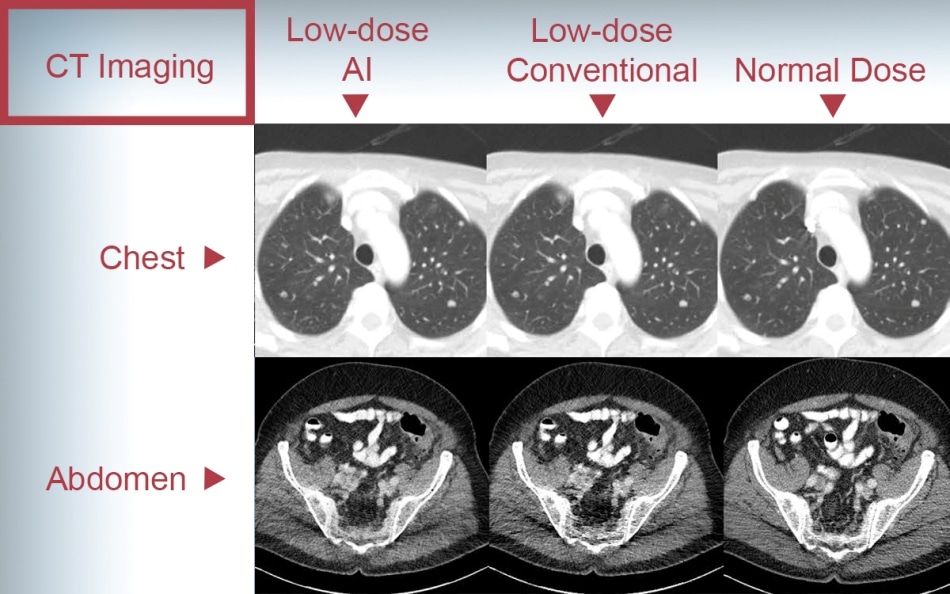Jun 11 2019
At Rensselaer Polytechnic Institute (RPI), a team of bioengineers has devised an artificial intelligence (AI) method that utilizes image post-processing to quickly change low-dose computed tomography (CT) scans to superior quality images, when compared to low-dose scans that do not utilize the AI method.
 CT images of the chest and abdomen produced using, from left, low-dose AI reconstruction, low-dose conventional iterative reconstruction, and normal dose CT. The image quality of low-dose AI is comparable and, in some cases, superior to conventional low-dose CT scans and it is faster. (Image credit: G Wang group, RPI/M Kalra group, MGH, and Harvard)
CT images of the chest and abdomen produced using, from left, low-dose AI reconstruction, low-dose conventional iterative reconstruction, and normal dose CT. The image quality of low-dose AI is comparable and, in some cases, superior to conventional low-dose CT scans and it is faster. (Image credit: G Wang group, RPI/M Kalra group, MGH, and Harvard)
The study received funding from the National Institute of Biomedical Imaging and Bioengineering (NIBIB).
In modern medicine, CT has turned out to be a commonly prescribed imaging service, offering a comprehensive, non-invasive, and close-up view of internal pathology and anatomy. With low-dose CT, a patient is subjected to less X-ray radiation.
This deep learning, hybrid, image-reconstruction technique integrates low-radiation dose CT images with emerging neural network methods and offers comparable images at much higher speed as those produced with iterative reconstruction methods. Dr. Wang’s team has advanced deep learning techniques for tomographic imaging and pursued this research with NIH grant support to improve image quality and computational efficiency for low-dose dose CT.
Behrouz Shabestari, PhD and Program Director, National Institute of Biomedical Imaging and Bioengineering
The NIBIB deals in deep learning, machine learning, and artificial intelligence.
With the growing use of CT scanning, this procedure accounts for 62% of the radiation dosage incurred by individuals in the U.S. from all imaging modalities. Although the danger of developing cancer from this radiation exposure is negligible, public concern has increased with the increasing use of CT scans, which made CT dose reduction a clinical objective. As a result, medical imaging engineers are working to create new technologies that can lower the radiation dose from CT without sacrificing its diagnostic performance.
CT scans are rebuilt from combinations of several X-rays obtained from various angles. In their study featured in Nature Machine Intelligence on June 10th, 2019, the researchers, headed by Mannudeep Kalra, M.D., associate professor of radiology at Harvard Medical School and radiologist at Massachusetts General Hospital, and Ge Wang, PhD, Clark & Crossan Endowed Chair Professor in the RPI Department of Biomedical Engineering, compared normal image reconstruction techniques from commercially available CT machines with an innovative technique, known as a modularized neural network. This latest method is a type of AI that is often referred to as deep learning or machine learning by researchers.
The modularized neural network meant for CT image reconstruction gradually decreases data noise in a way that enables radiologists to interactively take part in improving the reconstruction workflow. Radiologists can assess each small increment of enhanced image quality in accordance with the medical diagnosis they wish to make.
The team acquired low-dose CT scans of 60 patients, with 30 of them depicting chest anatomy and the other 30 depicting abdominal anatomy. The scans indicated three commercial CT scanner products, all of them already using iterative image reconstruction algorithms—the traditional method—to lower image noise. The noise results in reduced image quality owing to low radiation dose CT scanning.
The iterative reconstruction method refers to the repeated steps that are attempted by medical imagers for producing the CT images that are consistent with some previous knowledge about image content and imaging physics. Image reconstruction was eventually compared with presently used iterative approaches and the new deep neural network for post-processing of images.
Three radiologists assessed and scored images for a couple of features—image noise suppression and structural fidelity. The former emerges as arbitrary patterns on the image that detract from its clarity, while the latter refers to the image’s ability to precisely depict the anatomical structures in the field of view, which, incidentally, can be reduced by noise.
With regards to abdominal imaging, higher scores were given to images created with the modularized neural network technique on two of the three scanning devices and the images from the third device were considered as similar quality with the iterative reconstruction technique. In the case of chest imaging, the image quality was found to be similar between the two techniques for all devices. On the whole, the modularized neural network performed comparably or satisfactorily in relation to the iterative technique when the radiologists assessed noise suppression and structural fidelity.
The investigators added that their novel technique is relatively faster when compared to the present commercial techniques and that institutions with existing CT scanners of different brands can use their method to create comparable image results.
According to Wang, the study outcomes prove that deep learning can possibly help in creating high-quality CT images at lower dosages, and simultaneously, this new method is relatively more efficient when compared to the iterative technique, which not only takes a long time but is also subject to image noise artifacts.
The study was partly supported by a grant from NIBIB (EB017140) for research to create systems for low-dose CT.